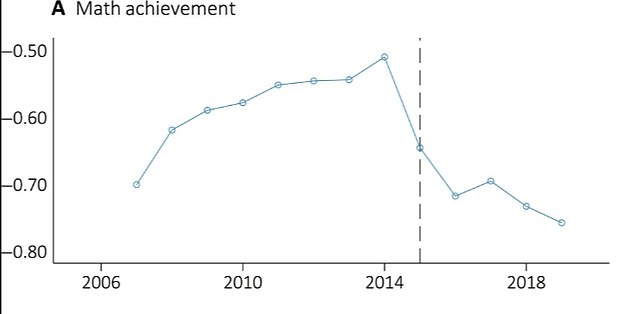The Flintwater crisis led to a spike in the number of children with special needs and a drop in school grades a decade later, according to research comparing the disaster’s effects to Chernobyl
The Flint water crisis has resulted in unprecedented numbers of children with special needs and poor performance in school.
More than 12,000 children were exposed to toxic levels of lead in 2014 when the city switched its public water source to the Flint River, where the water is significantly more acidic.
This led to corrosion in lead pipes, which saturated the city’s tap water with lead and then introduced it into the drinking water supply. Lead exposure has been linked to behavioral and cognitive problems, mental illness and an underdeveloped brain.
Researchers from Michigan and New Jersey have now reported that the number of young children with special needs increased by eight percent after 2014, while performance in math classes fell.
The number of children with special needs has increased by eight percent compared to 2014

Flint children with elevated blood lead levels doubled, from about 2.5 to 5 percent
The latest study used Michigan student education data obtained from the Michigan Education Data Center, which covers students from kindergarten through high school, looking at student outcomes from 2007 through 2019 .
They compared Flint’s schools to similar schools in other parts of Michigan using so-called synthetic control methods, which allowed them to create a “synthetic” or control version of Flint that did not face this water crisis.
We then analyzed data on metrics such as math and reading test scores, special needs status, and attendance to see how these changed after the crisis in Flint compared to our synthetic Flint.
As of 2015, math performance has dropped significantly for children in grades three through eight, who are roughly nine to thirteen years old.
They found an ‘average’ effect size by standards for educational interventions, with the equivalent of five months of learning progress lost, which had not yet been recovered in 2019.
Children from poorer families and children in grades 3 to 5 were hit hardest in math
During that time there was also an increase of 1.2 percentage points, or eight percent, in the proportion of students with documented special educational needs.
Boys saw a 10.9 percent increase in special needs, while girls saw a four percent increase.
The research was conducted by sociologists from the University of Michigan and Princeton University
They wrote in the paper: ‘Social and psychological processes also play an important role in shaping the outcomes of individuals living in crisis-affected communities.
‘For example, in assessing the long-term effects of the Chernobyl nuclear accident in Ukraine, a United Nations report concluded that the mental health consequences of increased fear, anxiety and trauma actually exceeded the physical health consequences of radiation exposure .’
Their findings were published in the journal Scientific progress.

Arithmetic performance dropped significantly. Statistical estimates suggest a significant decrease in math performance by 0.14 standard deviation (SD), which is within the range of a ‘medium’ effect size
Flint’s water was supplied by Lake Huron beginning in the 1960s. In 2011, as Flint’s government collapsed, then-Governor Rick Snyder appointed the first in a long line of government emergency managers charged with balancing the city’s budget.
To save money (about $7 million), officials switched to water from the Flint River in 2014. Meanwhile, the lead-laden pipes had not been replaced, causing the metal to end up in the tap water. Soon after the transition, residents noticed a new color and smell in their tap water.
It wasn’t until early 2015 that the EPA learned of the concerns about lead levels. Even after switching to Detroit’s water supply that year, the water in Flint remained unsafe and residents still drink contaminated water.
Reading performance remained about the same, possibly because previous studies have shown that a student’s math performance is likely to improve or deteriorate over a short period of time, while reading is a lifelong learning process.
A research team led by pediatrician Dr. Mona Hanna-Attisha found that the percentage of Flint children with elevated blood lead levels doubled between 2014 and 2016, from about 2.5 to five percent.
Despite the higher lead exposure experienced by children living in homes with lead pipes during the Flint Water Crisis (FWC), there was little difference in their academic performance compared to children living in homes with safer copper pipes.
It suggests that the wider consequences of the crisis, such as major social unrest and the general sense of crisis, apart from direct lead poisoning, had a greater impact on educational outcomes.
Last year, an EPA report found that there are more than 9 million lead service lines in the U.S. known as a “significant source” of lead contamination — used to transport drinking water to homes across the country.
In 2021, a US federal judge approved a $626 million payout to Flint residents whose water supply was poisoned by lead.
The bulk of the money — $600 million — comes from the state of Michigan, which has been accused of repeatedly overlooking the risks of using the Flint River without properly treating the water.
Lead is toxic to the brain and even a small amount of exposure can cause cognitive impairment. It is distributed over the entire body via the bloodstream and accumulates in various tissues.
Children are at particularly high risk of negative health effects because when lead is ingested, a greater proportion of lead is absorbed from the gastrointestinal tract into the bloodstream than in adults.
Even if children and adults are exposed to the same amount of lead, children are more likely to absorb a greater amount of lead into their bodies.
Lead exposure has also contributed to higher rates of anxiety and depression, lower test scoresimpulsivity and ADHD diagnoses, and violence or aggression.
